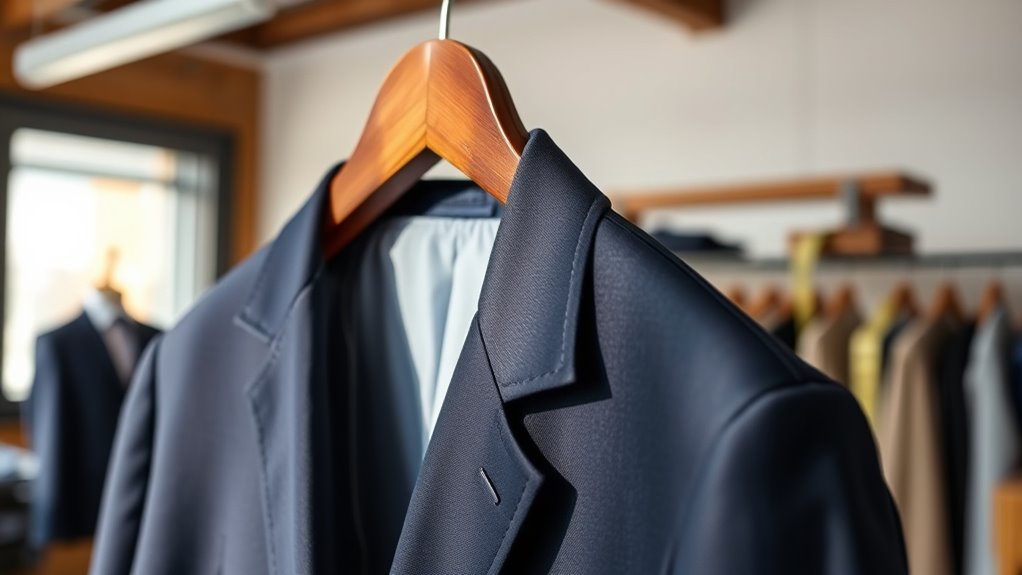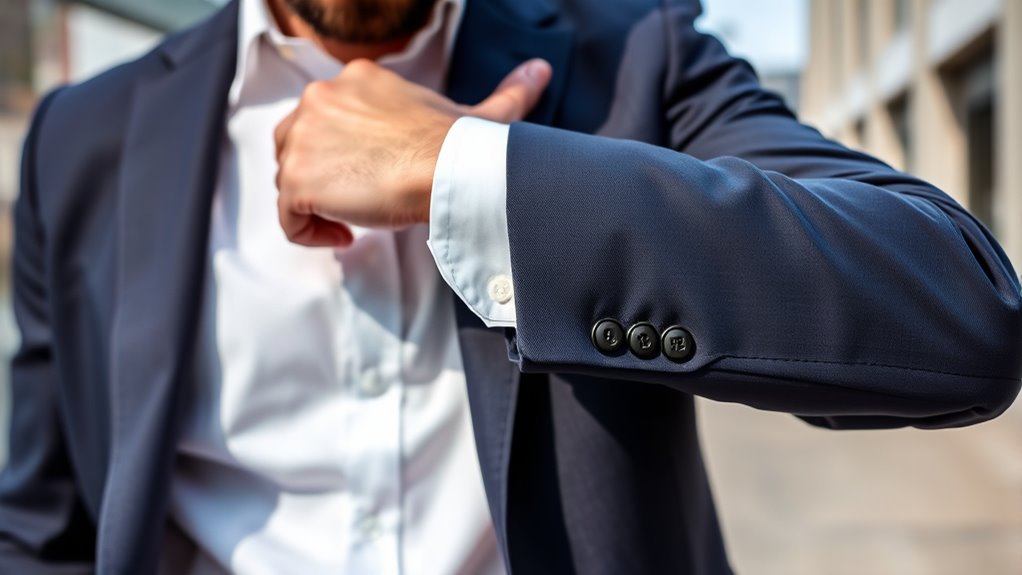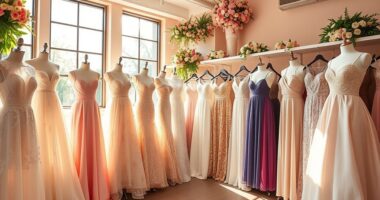Buying one size up and tailoring it smartly allows you to maximize your alteration allowance, ensuring a better fit and increased comfort. Choosing a larger size gives your tailor extra fabric to adjust shoulders, waist, or length for a polished, professional look. It also helps prevent clothing from feeling tight or restrictive. When you select the right fabric and communicate your preferences, you can create a wardrobe that fits perfectly and looks sharp. Keep exploring to discover how to make the most of this strategy.
Key Takeaways
- Buying one size up provides extra fabric for precise tailoring, ensuring a better fit and professional appearance.
- Choose durable, easy-to-tailor fabrics like wool or synthetic blends to optimize alterations and maintain uniform quality.
- Communicate your sizing preferences clearly to the tailor to maximize the effectiveness of the alteration allowance.
- Proper fabric selection and strategic sizing enable seamless adjustments without excess bulk or sagging.
- Combining a larger size with skilled tailoring results in comfortable, functional uniforms that enhance professional presentation.

An alteration allowance is a financial provision provided by employers to cover the cost of modifying or customizing a uniform or work attire. When you receive this benefit, you have the opportunity to invest in clothing that fits perfectly and feels comfortable, especially if you choose to buy one size up. Doing so allows you to enjoy a better fit, but it also requires a smart approach to guarantee your clothing remains professional and comfortable after alterations.
One of the key steps is selecting the right fabric. When opting for a size up, you want fabric that’s durable, easy to work with, and suitable for the garment’s intended use. Natural fibers like wool or cotton can offer breathability and comfort, but they may also require careful handling during tailoring. Synthetic blends, on the other hand, often resist wrinkling and shrinkage, making them easier to modify without losing shape. Choosing quality fabric assures that after custom tailoring, your uniform still looks sharp and holds up over time.
Selecting durable, easy-to-tailor fabrics like wool, cotton, or synthetic blends ensures a professional, long-lasting uniform fit.
Custom tailoring plays a pivotal role in transforming a larger-sized garment into a perfect fit. When you buy one size up, it gives the tailor more room to work with, especially around areas like shoulders, chest, and waist. A skilled tailor can take in excess fabric seamlessly, creating a clean, professional appearance. They can also adjust the length or sleeves to match your proportions precisely. Remember, the goal isn’t just to make the clothing fit but to enhance your overall appearance and comfort. Investing in custom tailoring guarantees that the extra fabric doesn’t turn into bulk or sag, but instead becomes a tailored fit that complements your body shape.
Using your alteration allowance wisely involves more than just buying big and hoping for the best. Focus on selecting a size that provides enough room for adjustments without turning your outfit into an oversized or baggy look. When choosing fabric, consider its ease of manipulation—some fabrics are easier to tailor than others. Communicate your preferences clearly with your tailor so they understand how much you want to take in or let out. This way, you maximize your allowance, ensuring the final look is polished and professional.
Ultimately, buying one size up with the intent to have it custom tailored is a smart strategy. It allows you to leverage your alteration allowance effectively, ensuring your work attire fits perfectly while maintaining a sharp appearance. By paying attention to fabric selection and working closely with your tailor, you’ll enjoy clothing that not only looks good but feels comfortable throughout your workday. Additionally, understanding the contrast ratio of your clothing can help you choose fabrics and styles that better suit your personal and professional needs.
Frequently Asked Questions
How Do I Determine the Right Size to Buy for Alterations?
When choosing a size for fit adjustments, you should prioritize how the garment feels and looks on you. Try on different sizes and focus on comfort and silhouette. Use styling tips like selecting a slightly larger size to allow room for tailoring. Remember, buying one size up can give you flexibility for alterations, ensuring a perfect fit. Always consider your body shape and garment purpose to make the best choice.
What Types of Clothing Benefit Most From a One Size up Purchase?
Think of it like a vintage suit, timeless yet adaptable—buying one size up works best for casual wear, oversized fashion trends, or seasonal styles where comfort and layering matter. You’ll find it ideal for jackets, sweaters, and relaxed-fit trousers, giving you room to breathe and style creatively. This approach guarantees you stay on-trend without sacrificing fit, making your wardrobe both versatile and comfortable.
Are There Specific Fabrics That Are Easier to Alter?
When considering fabrics that are easier to alter, look for those with good fabric flexibility, like cotton or jersey, as they stretch and move more easily. These fabrics typically have lower sewing difficulty, making adjustments simpler for your tailor. Avoid stiff or delicate materials like silk or chiffon, which can be challenging to work with. Choosing fabrics with better sewing ease guarantees your one size up purchase can be tailored perfectly.
How Does Alteration Allowance Vary Between Brands?
Oh, the delightful mystery of brand-specific sizing! You’ll find some brands generously offer alteration policies that make resizing a breeze, while others are as rigid as a wooden plank. It’s like a game of retail roulette—your perfect fit depends on their policies. So, always check each brand’s alteration allowances before buying, especially if you’re planning to buy one size up. Smart shopping means knowing their rules of the game!
Can Alteration Allowances Affect the Overall Cost of Clothing?
Yes, alteration allowances can impact your overall clothing costs. If a brand offers a generous allowance, you might save on alteration costs, making the purchase more budget-friendly. However, if the allowance is small, you’ll likely spend more on tailoring. When doing a cost comparison, consider both the initial price and potential alteration costs to determine the true value of your clothing investment.
Conclusion
So, next time you’re tempted to buy a size up just in case, remember that a little alteration can make that bigger fit perfect. It’s smarter and often cheaper than settling for something that doesn’t quite work. Plus, it’s a fun way to customize your look! Don’t let the idea of extra effort scare you—alterations are easier than you think, and you’ll love how much more confident you feel in that perfect fit.










